The Love Triangle Spread
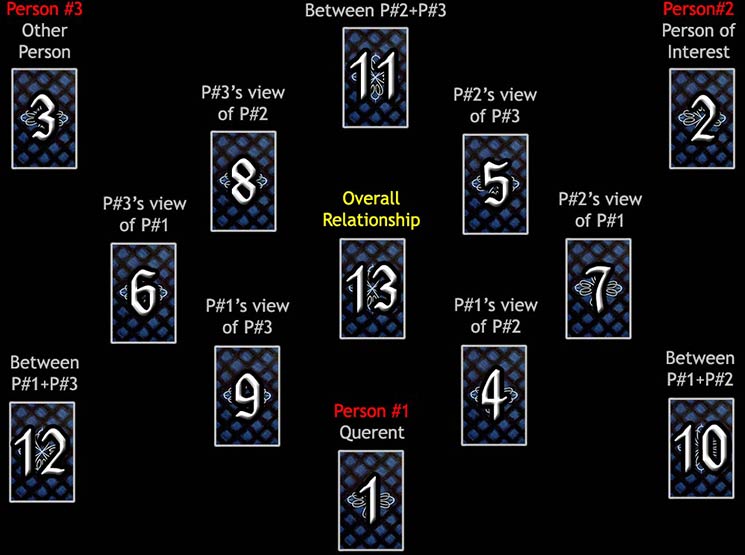
Difficulty: Complicated
Casually referred to as the Love Triangle, this spread can be used to determine the dynamics of the relationship between three people, regardless of whether romance is involved. This spread is arranged in the form of a hexagram, consisting of several large and small triangles. This tarot spread may seem somewhat complicated, but it is not entirely that difficult.
The first step is to interpret the card for each individual position in the spread. Generally, one might ask about a relationship they are involved in, but this does not have to be the case. Ordinarily, the reader's representative card is #1, their main person of interest is #2, and the other person would be #3.
The second step fills in the downward triangle and involves further examination of the individuals through their views of the other people. Each person has two more cards showing the way they see and relate to the other members of the triangle. For example, Card #6 indicates how Person #3 relates to Person #1, while Card #9 stands for Person #1's attitude toward Person #3.
The next step completes the upward triangle and the hexagram, focusing on cards #10–13. It also completes the many smaller triangles and hints at the potential for each relationship. The final card, #13 can be considered the significator of the reading, which suggests the overall potential for this three-way relationship.
Your Love Triangle Reading
| P#3 | 3to2 | 2+3 |
2to3 | P#2 | ||
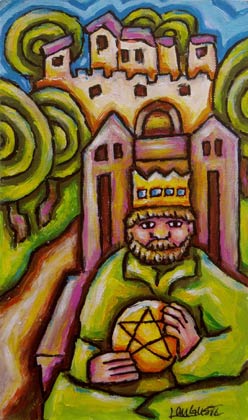 |
3to1 |  |
Overall | 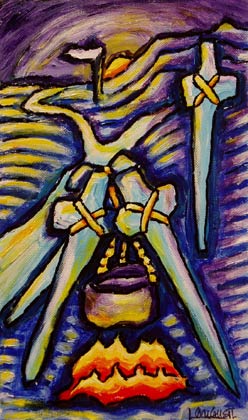 |
2to1 |  |
| 1+3 | 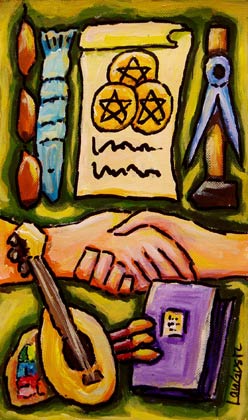 |
1to3 |  |
1to2 | 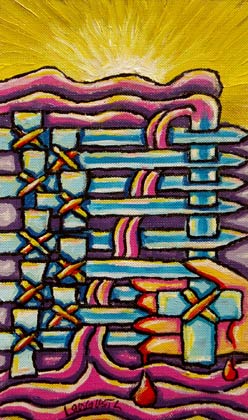 |
1+2 |
 |
 |
P#1 |  |
 |
||
 |
1: Person #1

Wealth and poverty are separated by a wall. The rich man is wearing white gloves. He doesn't want to get his fingers dirty. The poor man has a missing middle-finger, the centre has been lost. His stick is brittle.
The colour blue separates the colours red and yellow from brown and green. The yellow is similar to gold. Red used to belong to the most expensive colours. Green is also the colour of mould and brown is the colour which at first appears to be inert.
The candle is helping the poor man to find sense and the distant path, as far as he is aware of them.
2: Person #2

The two eyes indicate that the High Priestess perceives the polarity in their dualism but doesn't take any valuation into account. The light and the dark side can be seen, as well as the waning and waxing moon and the full-moon, which unites and contains both sides.
The water and the two fish also symbolise the connection, the flow of energy and the dualism. The feather stands for the High Priestess' sensitiveness, the pomegranate for her fertility.
3: Person #3

The king is sitting in front of his magnificent castle with its well-kept but simple park. He is proud of it and feels confident. He is aware of what he has achieved and he knows how to manage his estate.
4: Person #1's view of #2

This illustration, as with the previous ones, is based on classical examples. The moon can be seen foreshadowing its warmer and brighter side. Both towers, right and left of the path, are an indication of the Holy Jerusalem. The violet colour promises spiritual experience. To reach them the path leads past the wolf, which symbolises danger. The protecting force is portrayed by the dog, which appears lighter.
The crab, which is coming out of the water, describes the appearance out of the depths and the return to light. The crab also symbolises a character which has developed a strong contact to its emotions and intuition. Because of this it is very vulnerable and protects itself with armour and usually an extra covering.
5: Person #2's view of #3

Three swords are holding a violet cauldron, under which a fire is burning. Something is being "extracted". The violet colour indicates a spiritual process. The sun is setting; nothing more will happen today. To sleep on it will help.
Tomorrow it might be possible to grasp the fourth sword and to take the right path in further conflicts. The path past the white flag is also possible.
6: Person #3's view of #1

The picture shows an attestation as a symbol of real development and change, framed by symbols of different areas of life: a fish, sausages, a hammer and compass for handicrafts, a lute, a palette and brushes for art, a book for knowledge, appreciation and education, the two hands for social understanding.
7: Person #2's view of #1

Letting go of rationality is shown here as a dissolving process. Nine swords are cutting up a tenth sword, the point of which is melting and with this fluid wets the other nine swords.
The hand is injured by the four lower swords and is opening up; two drops of blood can be seen. It is not clear how many of the swords are or should be melting. The sun rising in the background brings with it new strength.
8: Person #3's view of #2

The striking red background of the picture shows that justice has to be very often looked for in emotional situations. Libra's sword and suspension are blue. This stands for rational action. The sword with its double cross the card's eight. The violet colour of the bowls shows the necessity for openness and entirety.
Both hands are equally involved in the weighing process. Rationality and intuition are both important. The eye is half open, it is looking both outwardly and inwardly. The fruits symbolise maturity, which has to reach a good decision for justice.
9: Person #1's view of #3

The throne-room looks very tidy, but at the same time very bare. The throne itself has hardly any decoration. The king is protecting himself by his complete dress; his coat of mail can be seen under his shirt; on his chest he is wearing the sign of Libra, an indication of his connection with justice and his role as a judge.
The two butterflies above him indicate that he shows a tendency towards black and white-thinking. The crown, with its three points, refers to the third element, air. His sword is not completely straight and the square tiles in the background emphasise, through the different tones of red, that life cannot be locked away into boxes.
10: Overall relationship between persons #1 and #2

The symbols of all the elements are shown on the picture as possibilities. The eye, with its triangular shape, refers to the Holy Trinity. It seems as though it has just opened and one can recognise the spokes of the Wheel of Fortune in its iris.
The ribbon of eternity shows us how all possibilities can develop in waves out of the one item. The red background supports the energy of the illustration.
11: Overall relationship between persons #2 and #3

The swords look like teeth, which at any moment could bite. The hands are held up for protection. The eye wants to open, but its vision is obstructed.
The waning moon emphasises the existing fear. The sunrise is at hand. Roses promise development, joy of life and the coming forth of emotions in the near future.
12: Overall relationship between persons #1 and #3

The beam in the Five of Wands picture has been supported. On this card a hand has taken over the leadership and restrained the different impulses from the other five hands, or as the case may be, straightened them up so that they cannot cause any more damage to the successful work. The top and the bottom of the picture show the two sides of the number seven.
13: Overall 3-way Relationship

Nine stars are pointing towards a goal. The violet colour in the picture illustrates the spiritual atmosphere, the blue water and the fish symbolise clarity, flow of energy and liveliness, the path is well lit and seems to become easier and the sky is clearing to a light blue.
The signs of the Zodiac point towards methods, which are occupied with one's own future, and act as deputy for all oracle techniques.
